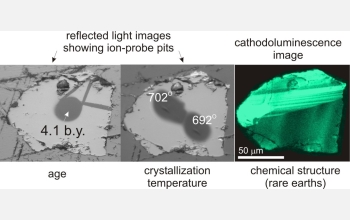News Release 05-068
New Thermometer Confirms Wet Conditions on Earliest Earth
Ancient zircons provide history
May 5, 2005
This material is available primarily for archival purposes. Telephone numbers or other contact information may be out of date; please see current contact information at media contacts.
Using a newly developed thermometer made of zircon, researchers have found evidence that environmental conditions on early Earth, within 200 million years of the solar system's formation, were characterized by liquid-water oceans and continental crust similar to those of the present day.
The findings are reported in the May 6 issue of the journal Science.
"Our data support recent theories that Earth began a pattern of crust formation, erosion, and sediment recycling as early in its evolution as 4.35 billion years ago, which contrasts with the hot, violent environment envisioned for our young planet by most researchers and opens up the possibility that life got a very early foothold," said Bruce Watson, a geochemist at Rensselaer Polytechnic Institute (RPI) in Troy, New York.
Watson collaborated with scientist Mark Harrison, affiliated with the Australian National University and UCLA, on the research. The work was also supported by the Australian Research Council and NASA's Astrobiology Institute.
Watson and Harrison developed a new thermometer that measures the titanium content of zircon crystals to determine their crystallization temperature. Zircons are tiny crystals embedded in rock and are the oldest known materials on Earth. Zircons pre-date by 400 million years the oldest known rocks on Earth. These ancient crystals provide researchers with a window into the earliest history of the Earth, and have been used to date the assembly and movement of continents and oceans.
"Zircons allow us to go farther back in geologic time because they survive processes that rocks do not," said Watson. "Although they are only a fraction of a millimeter in size, zircons hold a wealth of information about the very earliest history of Earth."
"This study solidifies the importance of zircons as time capsules of processes happening at the earliest time in Earth history," said Sonia Esperanca, program director in NSF's division of earth sciences, which funded the research.
According to Watson, the research provides important information and a new technique for making additional discoveries about the first eon of Earth's history, the Hadean eon, a time period about which little is known.
Using the new thermometer, the scientists analyzed zircons ranging in age from 4 billion to 4.35 billion years from the Jack Hills area of Western Australia. The temperature data supports the existence of wet, minimum-melting conditions within 200 million years of solar system formation, according to the researchers.
The researchers say the thermometer provides clear distinction among zircons crystallized in the mantle, in granites, and during metamorphism, thereby giving consistent information about the conditions on Earth during those crystals' formation.
Watson describes his research as "materials science of the Earth," because it involves designing and executing laboratory experiments at the high temperatures and pressures found in the Earth's deep crust and upper mantle.
-NSF-
Media Contacts
Cheryl L. Dybas, NSF, (703) 292-7734, email: cdybas@nsf.gov
Tiffany Lohwater, RPI, (518) 276-6542, email: lohwat@rpi.edu
The U.S. National Science Foundation propels the nation forward by advancing fundamental research in all fields of science and engineering. NSF supports research and people by providing facilities, instruments and funding to support their ingenuity and sustain the U.S. as a global leader in research and innovation. With a fiscal year 2023 budget of $9.5 billion, NSF funds reach all 50 states through grants to nearly 2,000 colleges, universities and institutions. Each year, NSF receives more than 40,000 competitive proposals and makes about 11,000 new awards. Those awards include support for cooperative research with industry, Arctic and Antarctic research and operations, and U.S. participation in international scientific efforts.
Connect with us online
NSF website: nsf.gov
NSF News: nsf.gov/news
For News Media: nsf.gov/news/newsroom
Statistics: nsf.gov/statistics/
Awards database: nsf.gov/awardsearch/
Follow us on social
Twitter: twitter.com/NSF
Facebook: facebook.com/US.NSF
Instagram: instagram.com/nsfgov



